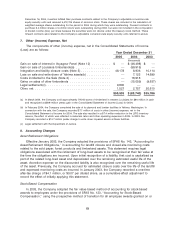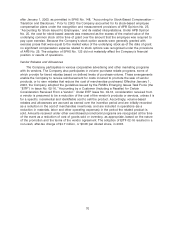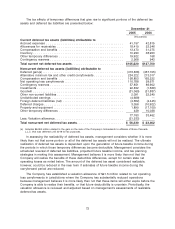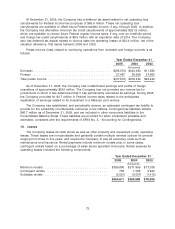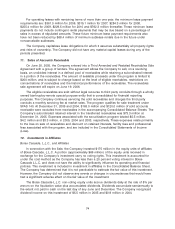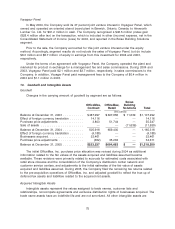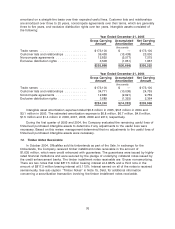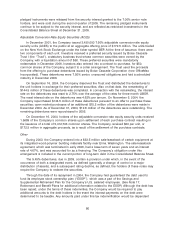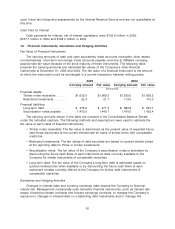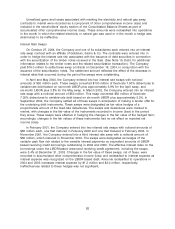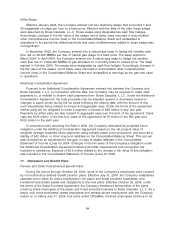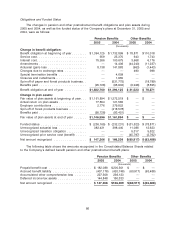OfficeMax 2005 Annual Report Download - page 83
Download and view the complete annual report
Please find page 83 of the 2005 OfficeMax annual report below. You can navigate through the pages in the report by either clicking on the pages listed below, or by using the keyword search tool below to find specific information within the annual report.notes will mature in 2020 and 2019, respectively. The securitization notes have an initial term that is
approximately three months shorter than the installment notes. The Company expects to refinance
its ownership of the installment notes in 2019 with a short-term secured borrowing to bridge the
period from initial maturity of the securitization notes to the maturity of the installment notes.
The guidance related to the accounting for the securitization transactions is complex and open
to interpretation. The original entities issuing the credit enhanced timber installment notes are
variable-interest entities (the ‘‘VIE’s’’) under FASB Interpretation 46R, ‘‘Consolidation of Variable
Interest Entities’’. The holders of the timber installment notes (the OMXQs, the bankruptcy remote
subsidiaries to which the Company transferred the notes in the securitization) are considered to be
the primary beneficiary, and therefore, the VIE’s are required to be consolidated with the OMXQ’s,
which are also the issuers of the securitization notes. Although the Company believes an argument
can be made that the consolidation of the VIE’s as a result of this transaction does not disqualify
the OMXQ’s from being qualified special purpose entities as described in SFAS No. 140,
‘‘Accounting for Transfers and Servicing of Financial Assets and Extinguishments of Liabilities,’’
management has concluded that consolidating the VIE’s does disqualify the OMXQ’s from meeting
this guidance. As a result, the accounts of the OMXQ’s have been consolidated into those of their
ultimate parent, OfficeMax. The effect of the Company’s consolidation of the OMXQs is that the
securitization transaction is treated as a financing, and both the timber notes receivable and the
securitization notes payable are reflected in the Consolidated Balance Sheet.
Note Agreements
In August 2003, the Company issued $50 million of 7.45% medium-term notes due in 2011.
The proceeds of the notes were used for general corporate purposes. On November 5, 2004, the
Company purchased $49.6 million of these notes pursuant to a tender offer.
In October 2003, the Company issued $300 million of 6.50% senior notes due in 2010 and
$200 million of 7.00% senior notes due in 2013. Net proceeds from the senior notes were used to
repay then outstanding borrowings under the Company’s revolving credit agreement, to provide
cash for the OfficeMax, Inc. acquisition and for other general corporate purposes. The Company
paid approximately $9.1 million in fees and expenses associated with the senior notes transaction.
The fees are being amortized over the terms of the senior notes. At the time of issuance, the senior
note indentures contained a number of restrictive covenants, substantially all of which have been
eliminated through the execution of supplemental indentures as described below. On November 5,
2004, the Company repurchased approximately $286.3 million of the 6.50% senior notes and
received the requisite consents to adopt amendments to the indenture pursuant to a tender offer for
these securities. As a result, the Company and the trustee executed a supplemental indenture that
eliminated substantially all of the restrictive covenants, certain events of default and related
provisions, and replaced them with the covenants contained in the Company’s other public debt.
Those covenants include a limitation on mergers and similar transactions, a restriction on secured
transactions involving Principal Properties, as defined, and a restriction on sale and leaseback
transactions involving Principal Properties.
On December 23, 2004, both Moody’s Investors Service, Inc., and Standard & Poor’s Rating
Services upgraded the credit rating on the Company’s 7.00% senior notes to investment grade. The
upgrades were the result of actions the Company took to collateralize the notes by granting the
note holders a security interest in $113 million in principal amount of General Electric Capital and
Bank of America Corp. notes maturing in 2008 (the ‘‘pledged instruments’’). These pledged
instruments are reflected as restricted investments in the Consolidated Balance Sheet. As a result of
these ratings upgrades, the original 7.00% senior note covenants have been replaced with the
covenants found in the Company’s other public debt. During the first quarter of 2005, the Company
purchased and cancelled $87.3 million of the 7.00% senior notes. As a result, $92.8 million of the
79


